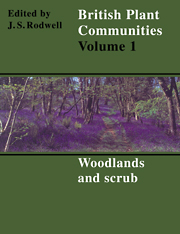Book contents
- Frontmatter
- Contents
- List of Figures
- Foreword
- Preface and Acknowledgements
- Preamble
- General Introduction
- Woodlands and Scrub
- Introduction to Woodlands and Scrub
- Key To Woodlands and Scrub
- Community Descriptions
- W1 Salix Cinerea-Galium Palustre woodland
- W2 Salix Cinerea-Betula Pubescens-Phragmites Australis Woodland
- W3 Salix Pentandra-Carex Rostrata Woodland
- W4 Betula Pubescens-Molinia Caerulea Woodland
- W5 Alnus Glutinosa-Carex Paniculata Woodland
- W6 Alnus Glutinosa-Urtica Jzozca Woodland
- W7 Ainus Glutinosa-Fraxinus Excelsior-Lysimachia Nemorum Woodland
- W8 Fraxinus Excelsior-Acer Campestre-Mercurialis Perennis Woodland
- W9 Fraxinus Excelsior-Sorbus Aucuparia-Mercurialis Perennis Woodland
- W10 Quereus Robur-Pteridium Aquilinum-Rubus Fruticosus Woodland
- W11 Quereus Petraea-Betula Pubescens-Oxalis Acetosella Woodland
- W12 Fagus Sylvatica-Mercurialis Perennis Woodland
- W13 Taxus Baccata Woodland
- W14 Fagus Sylvatica-Rubus Fruticosus Woodland
- W15 Fagus Sylvatica-Deschampsia Flexuosa Woodland
- W16 Quereus spp.-Betula spp.-Deschampsia Flexuosa Woodland
- W17 Quereus Petraea-Betula Pubescens-Dicranum Majus Woodland
- W18 Pinus Sylvestris-Hylocomium Splendens Woodland
- W19 Juniperus Communis Ssp. Communis-Oxalis Acetosella Woodland
- W20 Salix Lapponum-Luzula Sylvatica Scrub
- W21 Crataegus monogyna-Hedera helix scrub
- W22 Prunus Spinosa-Rubus Fruticosus Scrub
- W23 Ulex Europaeus-Rubus Fruticosus Scrub
- W24 Rubus Fruticosus-Holcus Lanatus Underscrub
- W25 Pteridium Aquilinum-Rubus Fruticosus Underscrub
- Index of Synonyms to Woodlands and Scrub
- Index of Species in Woodlands and Scrub
- Bibliography
W19 - Juniperus Communis Ssp. Communis-Oxalis Acetosella Woodland
Published online by Cambridge University Press: 04 July 2020
- Frontmatter
- Contents
- List of Figures
- Foreword
- Preface and Acknowledgements
- Preamble
- General Introduction
- Woodlands and Scrub
- Introduction to Woodlands and Scrub
- Key To Woodlands and Scrub
- Community Descriptions
- W1 Salix Cinerea-Galium Palustre woodland
- W2 Salix Cinerea-Betula Pubescens-Phragmites Australis Woodland
- W3 Salix Pentandra-Carex Rostrata Woodland
- W4 Betula Pubescens-Molinia Caerulea Woodland
- W5 Alnus Glutinosa-Carex Paniculata Woodland
- W6 Alnus Glutinosa-Urtica Jzozca Woodland
- W7 Ainus Glutinosa-Fraxinus Excelsior-Lysimachia Nemorum Woodland
- W8 Fraxinus Excelsior-Acer Campestre-Mercurialis Perennis Woodland
- W9 Fraxinus Excelsior-Sorbus Aucuparia-Mercurialis Perennis Woodland
- W10 Quereus Robur-Pteridium Aquilinum-Rubus Fruticosus Woodland
- W11 Quereus Petraea-Betula Pubescens-Oxalis Acetosella Woodland
- W12 Fagus Sylvatica-Mercurialis Perennis Woodland
- W13 Taxus Baccata Woodland
- W14 Fagus Sylvatica-Rubus Fruticosus Woodland
- W15 Fagus Sylvatica-Deschampsia Flexuosa Woodland
- W16 Quereus spp.-Betula spp.-Deschampsia Flexuosa Woodland
- W17 Quereus Petraea-Betula Pubescens-Dicranum Majus Woodland
- W18 Pinus Sylvestris-Hylocomium Splendens Woodland
- W19 Juniperus Communis Ssp. Communis-Oxalis Acetosella Woodland
- W20 Salix Lapponum-Luzula Sylvatica Scrub
- W21 Crataegus monogyna-Hedera helix scrub
- W22 Prunus Spinosa-Rubus Fruticosus Scrub
- W23 Ulex Europaeus-Rubus Fruticosus Scrub
- W24 Rubus Fruticosus-Holcus Lanatus Underscrub
- W25 Pteridium Aquilinum-Rubus Fruticosus Underscrub
- Index of Synonyms to Woodlands and Scrub
- Index of Species in Woodlands and Scrub
- Bibliography
Summary
Synonymy
Birch-juniper wood Tansley 1939; Juniper heath Pigott 1956a; Juniper scrub Poore & McVean 1957; Juniperus-Thelypteris nodum McVean & Ratcliffe 1962; Fern-rich juniper scrub McVean 1964a; Thelypterido-Juniperetum Graham 1971; Juniperus-Vaccinium nodum Huntley & Birks 1979a; Juniperus-Campanula nodum Huntley & Birks 1979a; Trientali-Juniperetum Birse 1980; Trientali-Betuletum pendulae Birse 1982 p.p.
Constant species
Juniperus communis ssp. communis, Agrostis canina ssp. montana, A. capillaris, Galium saxatile, Luzula pilosa, Oxalis acetosella, Vaccinium myrtillus, Hylocomium splendens, Thuidium tamariscinum.
Rare species
Linnaea borealis, Orthilia secunda, Potentilla crantzii, Pyrola media.
Physiognomy
Juniperus communis ssp. communis is always the most abundant woody species in this community, though some stands have an open over-canopy of birch, almost invariably Betula pubescens and usually ssp. carpatica, with multi-stemmed trees typically less than 10 m high and showing bushy, contorted growth (Forbes & Kenworthy 1973, Huntley & Birks 1979a; Birse 1980,1982). Increased amounts of birch, over juniper and the associated flora here, generally mark transitions to the Quercus-Betula-Dicranum woodland or, on somewhat less acidic and more fertile soils, the Quercus-Betula-Oxalis woodland. Such transitions often take the form of ill-defined mosaics (a feature especially well seen in the east-central Highlands of Scotland: Ratcliffe 1977, Huntley & Birks 1979a, b) and then separation of the different communities may be a question of the proportions of the two woody species. Similar problems can arise with Pinus sylvestris, which can occur here as isolated trees up to about 15m tall, but which thickens up considerably in zonations to the Pinus-Hylocomium woodland.
The cover and physiognomy of the Juniperus itself here are rather variable. Very widely scattered bushes within a heathy or grassy context would not qualify for inclusion in this woodland type, but many stands have less than 60% cover of juniper and extensive stretches of a closed canopy are rather exceptional: the usual picture is of a patchy cover with some more open areas and others where the bushes form a virtually impenetrable thicket. The individual bushes themselves are also of very diverse form: in some stands, low plants with decumbent branches reaching little more than a metre predominate; in others, pyramidal, conical or narrow, cylindrical forms are in the majority, occasionally attaining 5 m in height.
- Type
- Chapter
- Information
- British Plant Communities , pp. 316 - 326Publisher: Cambridge University PressPrint publication year: 1991



